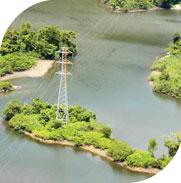
Environmental
PERFORMANCE


In 2008, CTEEP broadened the scope of its Environmental Management System, with the ISO 14001 certification of 38 substations.
In order to continue growing and expanding its operations while maintaining the principle of minimizing the environmental impact on the are Introductionas where it operates, CTEEP developed and implemented a series of measures in 2008, with the aim of broadening and strengthening its commitment to environmental sustainability in all its operations.
One of the main initiatives was the broadening of the scope of the Environmental Management System (SGA), with the ISO 14001 certification of 38 substations in 2008. This takes the number of certified substations to 58, raising from 20% to almost 60% the proportion of installations in compliance with the company’s system. The company also invests in the promoting a culture of environmental conservation among its employees, who receive activities to raise awareness and to increase familiarity with the system’s norms and procedures.The company continued to meet its commitments under the Environmental Conduct Adjustment Agreement signed in 2002 with the Environment Department of the State of São Paulo. The aim of this agreement is to bring transmission assets dating before and after 1981 into compliance with the respective Environmental Operating License laws.
In 2008, a total of R$ 171,700 was invested in environmental initiatives such as Environmental Management System audits and the Environmental Education program. In order to reduce the environmental impacts of its installations, the company maintains 132 collection ponds, 128 water-oil separation tanks and 116 firewalls at its substations. GRI EN30 e EN26
CTEEP’s environmental position also involves the adoption of simple behaviors that can bring benefits to all. In 2008, an area of 290 hectares was reforested, and 4,285 native seedlings were planted in areas such as parks, forestry institutes and suburbs.
Another initiative realized during the year was the reuse within the transmission process of 2 million liters of the mineral insulating oil used in the power transformers and reactors in the company’s electrical system. New technology was used to create a fully automated mobile insulating oil regeneration unit, which allowed CTEEP to save R$ 2 million and contribute to the conservation of the environment.
CTEEP also supports the Cuca Project, an environmental education program named after a character from a Brazilian children’s book, carried out in the Cantareira State Park in partnership with the NGO Instituto Guatambú, as a condition of the installation license for the Guarulhos-Anhanguera transmission line. The aim of the project is to encourage the development and application of activities for groups of students and the surrounding community, within and outside the park.
In 2008, a total of 2,600 cubic meters of inert debris was removed from under the company’s Interlagos/Embu-Guaçu transmission line and sent to registered landfills, and 17,532 fluorescent lamps were disposed of under a contract with a recycling company specializing in decontamination. Both cases were in compliance with environmental legislation. GRI EN24
Weight of transported, imported, exported, or treated waste deemed hazardous. GRI EN24
| Type of waste | Quantity | Unit |
|---|---|---|
| Asbestos | 31.00 | kg |
| Lead-acid batteries | 32 | unit |
| Dry cell batteries | 132.00 | kg |
| Mineral oil | 904.00 | l |
| Solids contaminated with oil, paint and solvents | 3,551.81 | kg |
| Electrical cable scrap | 922.25 | kg |
| Metal scrap | 1,279.27 | kg |
| Light bulbs | 1,227 | unit |
| Fluorescent lamp starters | 96 | unit |
| Assorted chemical products | 85.13 | kg |
| Polypropylene foam | 8.14 | kg |


